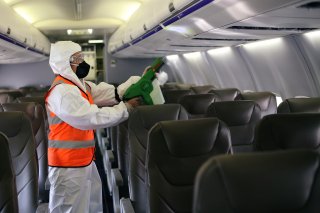Texas Plane Passenger in Her 30s Dies From Coronavirus
Although the death occurred on July 25, Dallas County officials only recently received the individual’s official cause of death, which is why it was announced now.
A Texas woman in her thirties died from the novel coronavirus while on an airplane this summer, Dallas County officials have announced.
The woman, who had underlying health conditions that were considered high risk, was on a flight from Arizona to Texas in July. The incident occurred while the plane was still on the tarmac.
“It became difficult for her to breathe, and they tried to give her oxygen. It is was not successful, and she died on the jetway,” County Judge Clay Jenkins said during an interview with NBC DFW.
Although the death occurred on July 25, Dallas County officials only recently received the individual’s official cause of death, which is why it was announced now.
Despite the United States still seeing tens of thousands of new coronavirus cases per day, the number of people taking to the skies is trending upward. According to the Transportation Security Administration (TSA), more than a million passengers were screened on Sunday, the highest figure since March 17.
“TSA has been diligent in our efforts to ensure checkpoints are clean, safe, and healthy for frontline workers and airline passengers, implementing new protocols and deploying state-of-the-art technologies that improve security and reduce physical contact,” TSA Administrator David Pekoske said in a news release.
The agency added that it screened 6.1 million passengers nationwide between October 12 and 18, the highest weekly volume since the start of the coronavirus pandemic.
Recent data and research are also showing that airline passengers face an extremely low risk of contracting the virus while flying.
For example, a recent study by the Department of Defense has discovered that—thanks in large part to high air exchange rates on planes and HEPA-filtered recirculation—the risk of aerosol spread of coronavirus is cut 99.7 percent.
On most planes, the air exchange rate is roughly every three minutes and 75 percent comes from outside the plane, which means that only 25 percent of cabin air is recirculated. It takes just six minutes for 99.99 percent of particles to be filtered out of the cabin.
In another case, 328 passengers and crew members were tested for the coronavirus after it was revealed that a March 31 flight from the United States to Taiwan had been carrying twelve passengers who were exhibiting coronavirus symptoms. But when the test results came back, all the other passengers and crew members tested negative.
One professor of statistics at the Massachusetts Institute of Technology made an effort to quantify coronavirus infection risk while flying. According to his findings—based on short-haul flights in the United States on aircraft with three seats on either side of the aisle and with all passengers and crew wearing face masks—the probability of being infected on a full flight is only one in forty-three hundred. Those odds plummet to one in seventy-seven hundred if the middle seat is vacant.
Ethen Kim Lieser is a Minneapolis-based Science and Tech Editor who has held posts at Google, The Korea Herald, Lincoln Journal Star, AsianWeek, and Arirang TV. Follow or contact him on LinkedIn.
Image: Reuters

